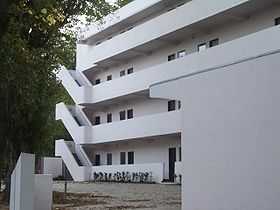Isokon

The London-based Isokon firm was founded in 1929 to design and construct modernist houses and flats, and subsequently furniture and fittings for them. Originally called Wells Coates and Partners, the name was changed in 1931 to Isokon, a name derived from Isometric Unit Construction, bearing an allusion to Constructivism.
Unusually for a design company, its directors were a bacteriologist Molly Pritchard, a solicitor Frederick Graham-Maw, son of the founder of the law firm, Rowe and Maw, Frederick James Maw and an economist Robert S Spicer. In actuality, the company was run by Molly's husband Jack Pritchard whose initial involvement was to handle the economics, publicity and marketing, but who later went on to hire designers and direct the company.
Isokon was never commercially successful. The end came when World War II began and its supply of plywood was cut off. The Isokon Furniture Company ceased production in 1939.
Lawn Road Flats
Isokon's key project was the Lawn Road Flats in Hampstead, sometimes called the Isokon building, which opened on 9 July 1934. Intended to be the last word in contemporary modernist living, the block of flats were aimed at the market of new young professionals of the 1930s and contained 22 single flats, four double flats, three studio flats, staff quarters, kitchens and a large garage. In 1937 a club, the Isobar, was added to the complex.
The flats and particularly the bar became famous as a centre for intellectual life in North London. Famous residents included Agatha Christie, and regulars at the Isobar included Henry Moore, Barbara Hepworth and Ben Nicholson.
In July 2014, the building's garage was converted into a gallery space with a permanent exhibition that tells the story of the building, its residents and the Isokon Furniture company.
Bauhaus in London
In 1935, Walter Gropius, the former head of the Bauhaus, became Controller of Design for Isokon. He arrived in England on 18 October 1934 and lived in one of the Lawn Road Flats until March 1937, when he and his wife left for USA. A month before he left for the USA, Gropius recommended Marcel Breuer, a former colleague at the Bauhaus, as his replacement for Controller of Design. The furniture Breuer designed whilst at Isokon are highly influential pieces of the modernist movement, and included chairs, tables and the Long Chair.
László Moholy-Nagy, another former Bauhaus teacher, also became involved with Isokon when he arrived in Britain from Germany in May 1935 and designed promotional material, including sales leaflets, showcards and the logo of Isokon firm itself, which was an outline of curved plywood chair.
Isokon revival
Jack Pritchard revived Isokon Furniture Company in 1963. Changes in the manufacture of plywood meant a redesign of some of the key pieces in the Isokon portfolio, for which Pritchard hired Ernest Race. In 1968, Pritchard licensed John Alan Designs to produce the Long Chair, Nesting Tables and the Penguin Donkey 2 which the company did until 1980.
Jack and Molly retired to their home designed by Jack's daughter Jennifer Jones and her husband Colin in 1966. The modern house called Isokon, turns heads to this day in Blythburgh, Suffolk.
In 1982, Chris McCourt of Windmill Furniture took over the license to manufacture Isokon pieces. Since 1999 this furniture has been sold through the retail arm of Windmill’s, Isokon Plus in Chiswick, London.
The first furniture to be added to the Isokon portfolio in over fifty years was designed by BarberOsgerby. Edward Barber and Jay Osgerby had recently graduated from the Royal College of Art when they designed their first piece, the Loop Table, in 1996. The iconic bent plywood design was to be the first of several furniture pieces that the designers created for Isokon Plus.
Isokon furniture
- Isokon Stool (designer unknown, 1933)
- Isokon Book Units (designed by Wells Coates, 1933)
- Desk made from Isokon Book Units (designed by Wells Coates, 1933)
- Aluminium Waste Paper Basket (designed by Walter Gropius, 1935)
- Side Table GT2 (designed by Walter Gropius, 1936)
- Isokon Nesting Tables (designed by Marcel Breuer, 1936)
- Isokon Dining Table (designed by Marcel Breuer, 1936)
- Isokon Stacking Chairs (designed by Marcel Breuer, 1936)
- Isokon Long Chair (designed by Marcel Breuer, 1935-6)
- The Pocket Bottleship (designed by Egon Riss, 1939)
- The Pocket Bottleship Mark 2 (designed by Ernest Race, 1963)
- The Penguin Donkey (designer by Egon Riss, 1939)
- The Penguin Donkey Mark 2 (designed by Ernest Race, 1963)
- Loop Table (designed by BarberOsgerby, 1996)
- Flight Stool (designed by BarberOsgerby, 1998)
- Home Table (designed by BarberOsgerby, 2000)
- Shell Table and Chair (designed by BarberOsgerby, 2002)
- Portsmouth Bench (designed by BarberOsgerby, 2002)
References
Grieve, Alastair. 2004. Isokon: For Ease, For Ever. London: Isokon Plus. ISBN 0-9548676-0-2.
External links
- Isokon Gallery — Gallery space telling the story of the Isokon building, notable residents and Isokon furniture
- Jack Pritchard — The Pritchard Papers, UEA Norwich
- John Craven Pritchard (Jack) — Archives Hub
- Isokon at Blythburgh — Alan Mackley
- Isokon Designers — Isokon Plus
- BarberOsgerby — Edward Barber and Jay Osgerby